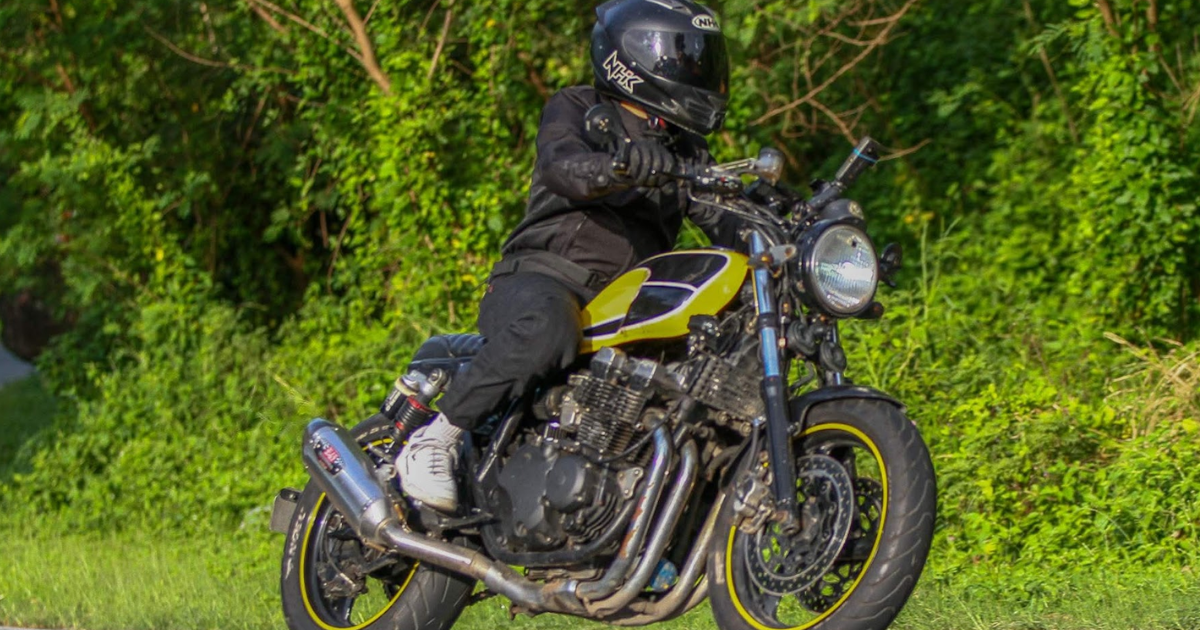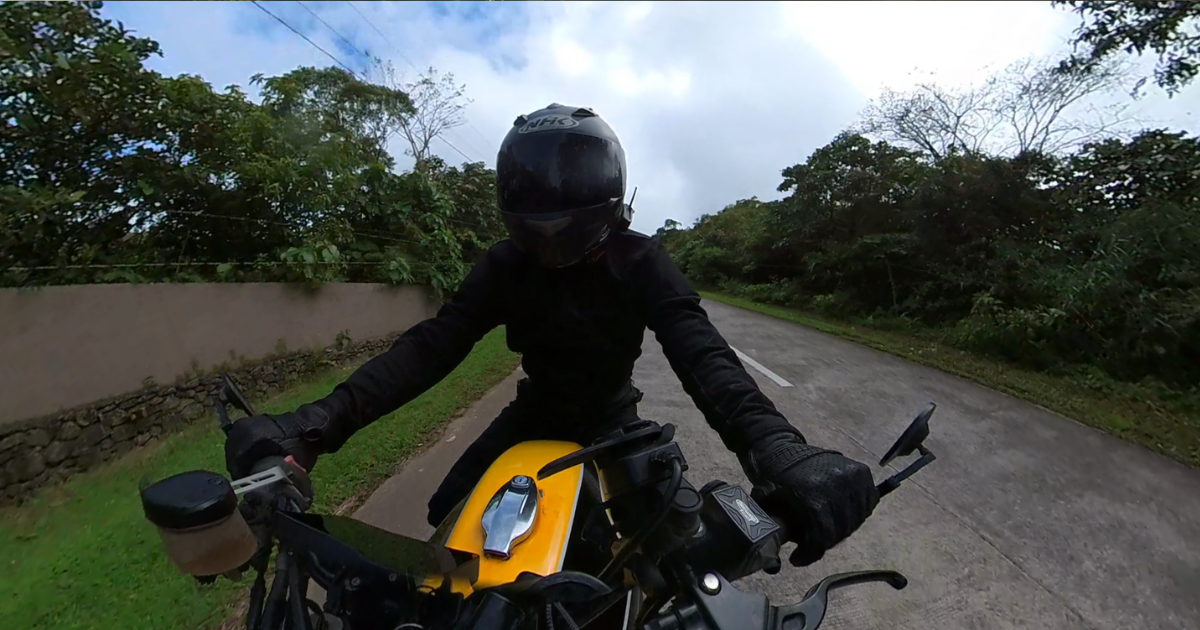
Chigee AIO 5 Lite Review: Minimal Space, Maximum Features
left for contents
I used to think motorcycle infotainment was just about playing music and following maps, until my basic system stopped working after barely eight months. That failure sent me searching for something more reliable—and more capable—than a simple screen with Bluetooth. I wanted a unit that could provide real benefits for my rides, not just show me the way home.
What drew me to the Chigee AIO 5 Lite was its promise of an all-in-one solution. It offers a 5-inch touchscreen display, front and rear Sony cameras for recording rides, an external GPS module so your navigation doesn’t depend on your phone, real-time tire-pressure monitoring (TPMS), and a handlebar-mounted remote for hands-free control. In short, it takes many devices you might carry separately and puts them into a single package.
A compact, handlebar-mounted CarPlay/Android Auto display designed for versatile use across motorcycles paired via Bluetooth with external tire pressure sensors for real-time safety monitoring and seamless ride data integration.
- Simple mount, quick install
- Real-time TPMS via sensors
- Compact, glove-friendly screen
- Dual Bluetooth pairing support
- App-based nav + ride data
- External sensors need battery swaps
- Mounting must avoid vibrations
I set out to see if this feature-rich device could handle the realities of motorcycle travel. To test it, I installed it on the SVT650X and embarked on a single 250 km morning ride through sun, rain, and dark night conditions—essentially a full day of everything you could throw at a motorcycle infotainment system. The goal was to determine whether the features it offers actually translate into a smoother, safer, or easier ride.
The 250 km Ride: Beyond the Spec Sheet
Morning optimism
When you first mount the Chigee unit on your bike, it feels solid and professionally built. The screen is vivid, and the controls are intuitive enough that you can start using it right away. Leaving before dawn, I was impressed by how bright and clear the display looked. The unit felt like a small tablet with motorcycle-specific features.
As we rolled through the countryside at highway speeds, the maps were responsive, and the music controls worked flawlessly. The vibrant display remained legible even in direct sunlight. I’d never had an infotainment unit this bright or responsive; it made my previous basic system seem primitive.

Even better, the touchscreen responded instantly even with thick gloves on, so I didn’t have to fumble or press twice. The layout of the widgets—navigation, music, calls, and camera—felt intuitive, almost like a smartphone adapted for two wheels. It struck me that instead of just “using” the unit, I was actually relying on it within minutes of the ride starting, which is exactly what you want when your attention should be on the road.
Wondering how the Chigee AIO-5 Lite stacks up against Carpuride? We break down where it pulls ahead in navigation, cameras, and riding.
Weathering the storm
An hour into the trip, the clear sky turned grey, and before long, we were riding through a heavy downpour. The kind of rain that blurs your visor and slicks the road in seconds. It was the type of weather that usually pushed my old system past its limits—screens would freeze, touch response would lag, and eventually, it would just shut down.
But this time was different. The Chigee didn’t miss a beat. The touchscreen remained fully responsive, even with water streaming across it. There was no lag, no glitches, and no need to second-guess any interaction. The user interface stayed fluid and clear, which meant I could trust it to work when I needed it most—without pulling my attention away from the road.
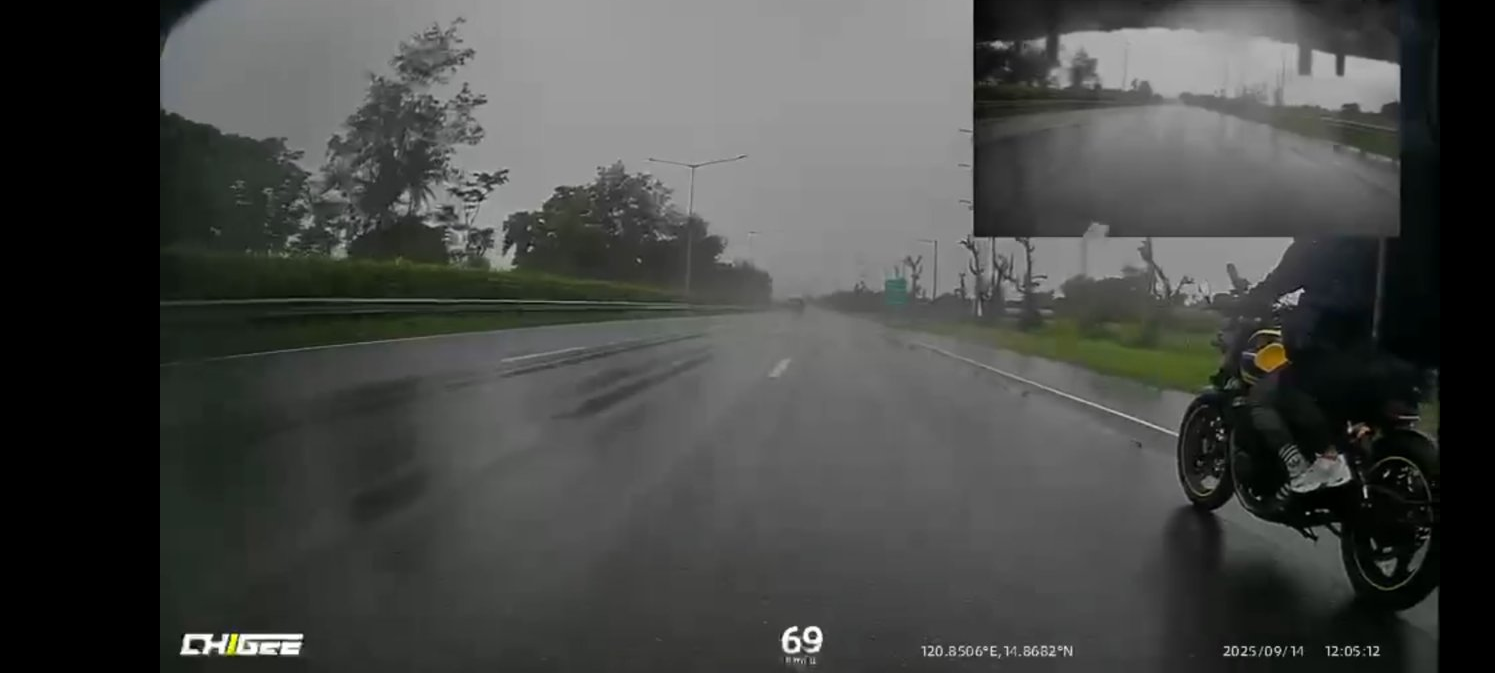
Riding in the rain is never easy, no matter how advanced your gear is. But knowing that the system could handle the weather without a hiccup added a quiet layer of confidence to the ride. In a situation where every distraction could be costly, not having to worry about the tech meant I could focus entirely on navigating safely through the storm.
Unboxing and First Impressions
Opening the Chigee package immediately reveals a step up in build quality from basic infotainment systems. Everything is neatly organized in custom-cut foam, a hint that the manufacturer expects the unit to last. The main components include:
- Main Unit: A 5-inch touchscreen display with a rugged, weather-resistant housing.
- Dual Sony Cameras: Front and rear cameras on adjustable mounts.
- External GPS Module: A small unit for independent satellite lock.
- Main Harness: A wiring loom with sturdy, weather-sealed connectors.
- Mounting Hardware: Various brackets, screws, and clips needed for installation.
The main unit is solid but large. On an adventure-oriented machine like the SVT650X, this size feels appropriate; on a smaller bike, it may dominate the cockpit. The size trade-off pays off in screen quality and durability.
Build quality: Over-engineered, not under-built
Compared to my previous infotainment system, the Chigee feels over-engineered. The cables are thick and well-shielded, connectors snap together with authority, and the mounts feel like they belong on a professional instrument panel rather than a consumer gadget. Nothing feels flimsy or prone to failure.
Even the foam inserts in the packaging show that the manufacturer expects users to move these components around and install them without damaging anything.
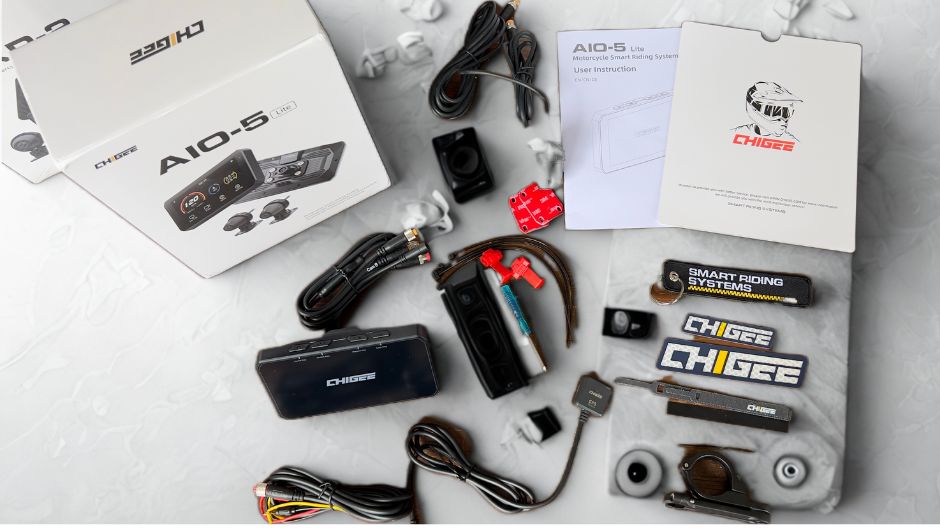
It’s clear from the start that this system is designed to handle the abuse of long rides and rough weather. If you’re upgrading from a basic screen like I did, the first impression is that you’re about to install something much closer to a professional recording and navigation system than a simple gadget.
Need the right navigation setup? Our guide to the best motorcycle GPS units of 2025 ranks options by budget, features, and rider style.
Display Performance: Brightness, Responsiveness, and Design
Sunlight readability that lasts
The 5-inch IPS LCD on the Chigee is the centerpiece of the system. During the 250 km ride and in months of subsequent use, it has remained bright and easy to read. The auto-brightness sensor ramps up quickly when sunlight hits the screen directly, ensuring that maps and controls stay visible. Unlike my previous system, which gradually dimmed over time, the Chigee’s display shows no signs of degradation.
Whether you’re riding through forests, under open skies, or past reflective surfaces, the screen adjusts to keep information visible. On bright days, the high maximum brightness makes it easy to glance at the map, and in dark conditions, the backlight dims to avoid blinding the rider.

This is a feature I learned to rely on; with my old system, I often had to shade the screen with a hand or wait for a cloud to pass to see what it was telling me.
Responsiveness without lag
Responsive controls are crucial when you’re riding. You can’t afford to tap twice or wonder if the system registered your input. With 4 GB of RAM and a customized Android interface, the Chigee performs more like a smartphone than a traditional bike accessory. Menus open immediately, apps load without delay, and the system responds even if your gloves are wet.
One of the design choices I appreciate is the layout of the home screen. Large widgets give quick access to music, navigation, phone calls, and camera controls. These icons are spaced far enough apart that you won’t accidentally press the wrong one while bouncing down a rough road.

This interface seems tailored to riders who need to operate the system at a glance, not to tinker with settings at a stoplight.
Interface limitations
The only honest downside to the display is its physical size. On the SVT650X, I had to remove other accessories to fit the Chigee. On a smaller motorcycle, this might mean losing space for a handlebar bag or phone mount. The unit’s bulk could be a deal-breaker if you prefer a minimalist cockpit, though on an adventure or touring bike, it’s less of an issue and might even add to the aesthetic.
Camera System: Recording Your Ride
Daytime and weather performance
The dual Sony cameras are one of the features that set the Chigee apart from most infotainment systems. During daytime riding, both cameras delivered high-quality footage. Colors are accurate, details are sharp, and there’s enough dynamic range to capture both the road and the sky without the image blowing out or going dark.
In my case, recording the entire 250 km ride produced clear footage that could be used for ride documentation or content creation. I expected the cameras to show water streaks or drop in quality. Instead, the hydrophobic coating on the lens covers helped water bead off quickly, maintaining visibility. You can still see the rain in the video, but it doesn’t obscure the scene.
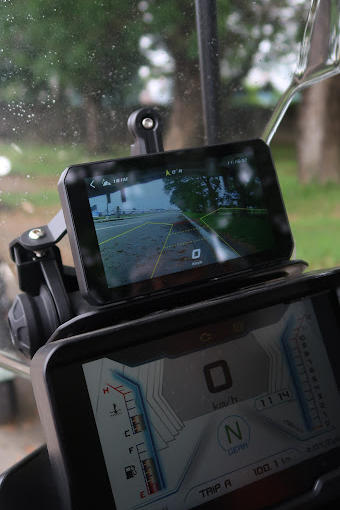
This level of weather performance is a big step up from a simple action camera stuck to the bike or from not recording at all, as was the case with my previous system.
Operational ease
The cameras automatically start recording when you turn on the bike. You don’t need to press a separate button, and there’s enough storage to capture hours of footage. Files are saved on removable media, making it easy to transfer and review them. If you want to manually save a clip—perhaps after an interesting moment or near-miss—the handlebar remote includes a button to mark and save footage without reaching for the screen.
GPS: Vehicle Data
My previous setup relied entirely on my smartphone for navigation, which meant no map if the battery died or signal dropped. While the Chigee includes an external GPS module, it’s important to note that this module is used exclusively for vehicle speed and system data, not for phone-independent navigation.
Navigation still depends on your smartphone and the connected apps, so if your phone battery dies or loses signal, you’re still without guidance. That said, the external GPS enhances the Chigee’s ability to provide real-time speed, ride data, and performance metrics, maintaining a strong satellite lock even in dense forests, urban canyons, or during heavy rain.

During our 250 km ride, the Chigee maintained accurate speed and data tracking throughout. While navigation still runs through your smartphone, the display integration and interface feel close to using a dedicated automotive GPS — just tailored for motorcycles.
Smartphone Integration: Wireless Convenience
Bluetooth audio is the most basic form of phone integration, but the Chigee goes much further with wireless CarPlay and Android Auto support. This means you can access many of your phone’s apps—music streaming, messaging, calls, and navigation—directly on the Chigee display. The connection has been rock solid during my rides. My phone pairs automatically as soon as I start the bike, and stays connected until I switch the bike off.
Navigating via smartphone apps
Wireless smartphone integration gives you that option without forcing you to mount a phone on your handlebars. Just start navigation on your phone, and it appears on the Chigee screen. The system balances convenience: if you want the independence of built-in GPS, you have it; if you want your phone’s navigation, that’s available too.
What stood out most was how seamless the switch felt between modes. I could leave home relying on the independent GPS for a signal-strong route, then switch to Android Auto when I needed live traffic updates from my phone. The integration never felt clunky or forced—both options worked smoothly, giving me flexibility depending on the ride.
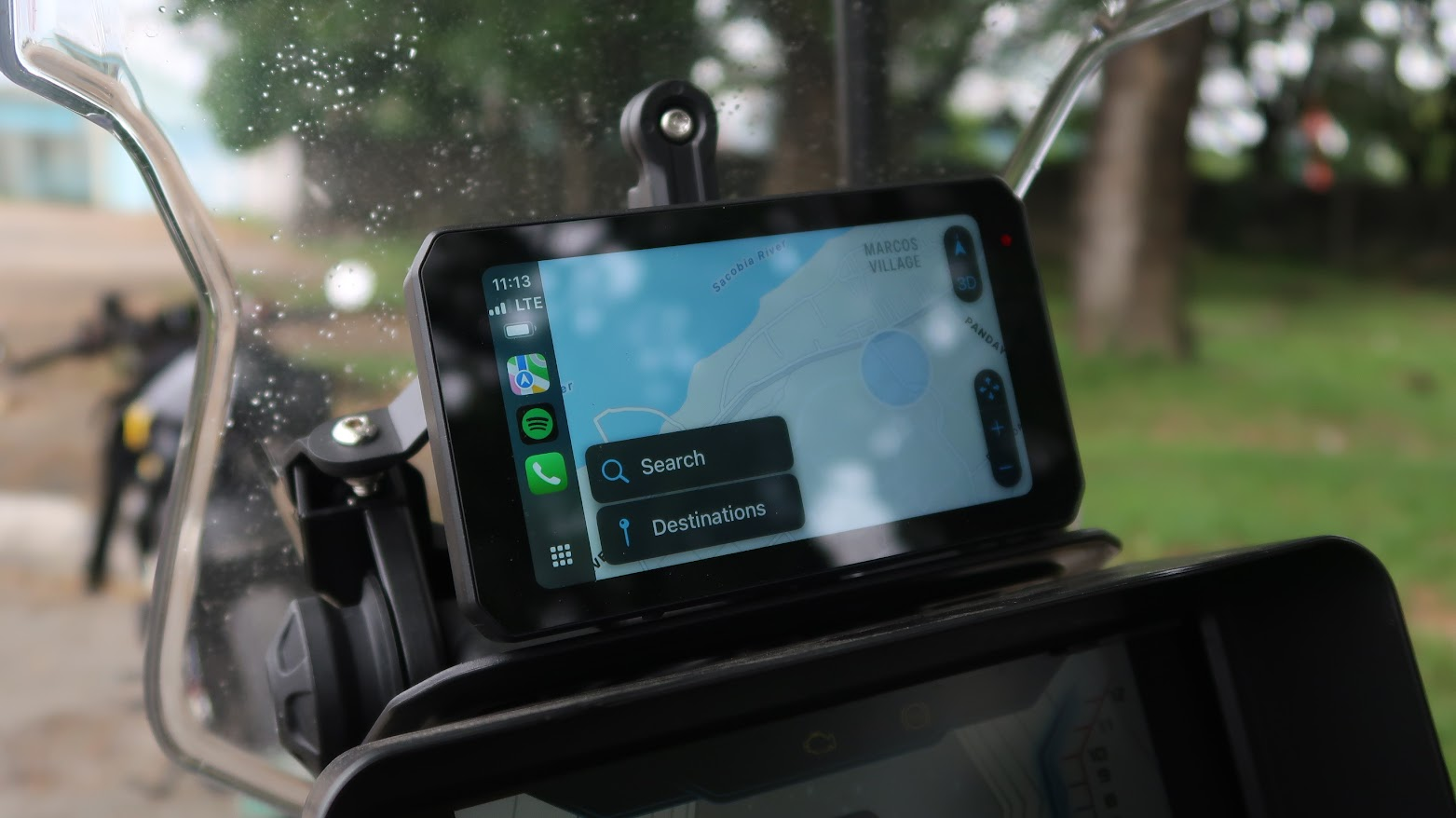
One trade-off is battery drain. Wireless connectivity uses more power than simple Bluetooth. I found that, for longer rides, it’s best to plug the phone into the USB port for charging. For shorter trips, wireless worked perfectly and spared me from fiddling with cables.
Camera Hardware: Sensor, Resolution, and Field of View
Each of the two dash‑cam modules—one for the front and one for the rear—is built around Sony’s IMX307 image sensor. This STARVIS‑class sensor is known for good low‑light performance, which helps explain why the AIO 5 Lite can capture usable footage at night despite headlight glare.
Chigee pairs the sensor with a six‑element (6P) glass lens featuring a 150‑degree field of view. The wide angle ensures both cameras capture a broad swath of the road, aiding situational awareness and providing context in recorded clips.

Resolution options include 1920 × 1080 p (Full HD) and 1920 × 720 p at 30 frames per second, which strike a balance between clarity and manageable file sizes. The lens has a large f/1.8 aperture to admit plenty of light, helping the cameras maintain detail in dim conditions. These specifications put the AIO 5 Lite on par with many dedicated dash cams.
Remote Control: Keeping Hands on the Bars
One of my biggest complaints about my previous infotainment unit was that I had to touch the screen for everything. The Chigee addresses this with a small handlebar remote that makes common tasks much safer. The remote has several buttons for controlling music playback, answering or ending calls, and starting or stopping camera recording.
Safety and usability
Using the remote means you can keep both hands on the handlebars and your eyes on the road. The buttons are large enough to operate with thick gloves, and they provide tactile feedback so you know when you’ve pressed them. I appreciated this feature most in the rain when the touchscreen was wet; the remote offered a reliable alternative for essential functions.

Learning curve
There’s a bit of a learning curve to remembering which button does what, especially if you’re used to reaching for your phone or the screen. After a few rides, muscle memory develops, and you can control playback, answer calls, or save video clips without thinking about it. This hands-free capability greatly reduces distractions and makes the overall system feel more integrated with the riding experience.
Installation: Complexity vs. Capability
Installing the Chigee system is not a quick plug-and-play exercise, particularly if you want to use every feature. It took me several hours to do a clean installation on the SVT650X, including:
- Mounting the main display securely.
- Positioning the front and rear cameras and routing their cables.
- Installing the external GPS module for clear sky exposure.
- Wiring the TPMS sensors to the wheels and linking them to the system.
- Mounting the handlebar remote.
- Connecting the main harness to the bike’s power supply and ensuring all connections were weather-sealed.
Skill level and tools
I didn’t take on the installation myself. While I’m comfortable with general bike maintenance, the Chigee setup involves more than just plugging in a screen. With multiple components to mount and wires to route, I chose to bring it to a trusted shop instead.
At the shop, the technicians laid everything out and planned the cable routing carefully. They mounted the GPS module, positioned the cameras, and ensured all connections were weatherproof and secure. Watching them work showed me how much attention to detail goes into making sure the system holds up under vibration and rain.
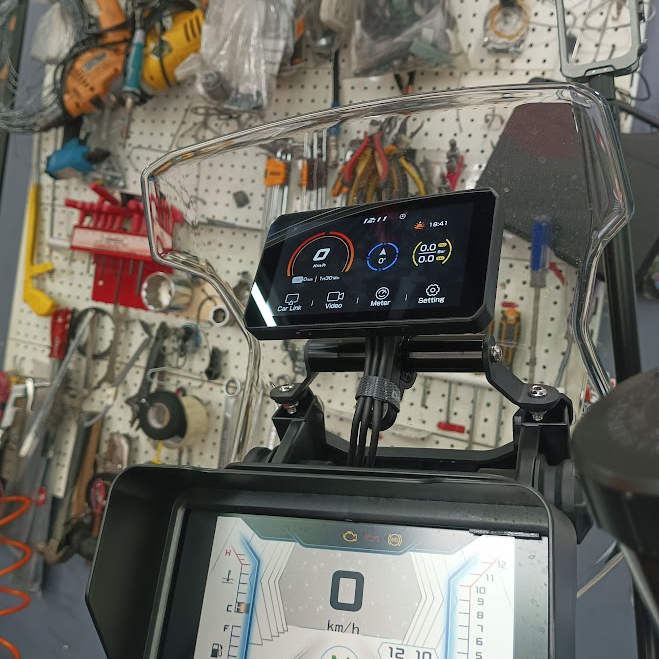
The entire process took a couple of hours, but the results were worth it. When finished, the setup looked clean and almost factory-installed—no loose cables, no awkward mounting. Honestly, I wouldn’t have achieved that level of polish on my own, so leaving it to professionals was the right call.
Exploring off-road or long-distance touring? These motorcycle navigation adventure devices were tested for ruggedness, reliability, and ADV practicality.
Value Proposition: Comprehensive vs. Basic
The Chigee AIO 5 Lite costs about $400–$450, which is a significant investment compared to the inexpensive, basic unit I had before. However, the value becomes clearer when you consider the features it replaces. With the Chigee, you get:
- Dual cameras with Sony sensors for front and rear recording.
- Independent GPS navigation.
- A TPMS system that continuously monitors tire pressure.
- Wireless CarPlay/Android Auto integration.
- A handlebar remote for safe control.
- A durable touchscreen display that holds up in all weather.
If you attempted to match these capabilities with separate devices—a pair of action cameras, a standalone GPS unit, a TPMS kit, and a phone mount—you would spend more money and end up with more clutter. By integrating everything, the Chigee simplifies your cockpit and ensures that all components work together.

Investment protection
The durability and build quality suggest this system is built to last far beyond the eight-month lifespan of my previous unit. When you factor in the reliability, the cost becomes an investment in safety and convenience. It might not be for everyone—especially riders who rarely travel long distances or can live without recording their rides—but for those who need these features, it offers good value.
Final Verdict: Reliability Plus Capability
No product is perfect, and the Chigee AIO 5 Lite has its limitations. The physical size might overwhelm a small bike’s cockpit, installation is complex, and the cameras have predictable limitations when faced with bright lights at night. Nevertheless, after a demanding 250 km ride and months of use, the Chigee has proven reliable where my previous system failed miserably.
Pros and cons
Pros
- Robust build quality with weatherproofing and vibration resistance.
- Bright, responsive display that remains clear in sunlight and rain.
- Dual cameras provide valuable ride recording in various conditions.
- Independent GPS navigation and reliable smartphone integration.
- Handlebar remote improves safety and ease of use.
- Comprehensive feature set consolidates multiple devices into one.
Cons
- Size may not suit smaller or minimalist bikes.
- Installation requires time and some skill.
- Higher upfront cost compared to basic infotainment systems.

Overall rating
I rate the Chigee AIO 5 Lite an 8.5 out of 10. It earns high marks for reliability, feature integration, and sustained performance under everyday conditions. Where it loses points is in the installation process, which can be a bit more involved than expected, and the camera’s limited performance in low-light conditions—an area where there’s still room for improvement.
That said, if you prioritize safety, comprehensive functionality, and long-term reliability, and you’re upgrading from a more basic system that’s let you down, the Chigee AIO 5 Lite should be at the top of your list. It’s not just a tech upgrade—it’s a confidence booster on the road.
A compact, handlebar-mounted CarPlay/Android Auto display designed for versatile use across motorcycles paired via Bluetooth with external tire pressure sensors for real-time safety monitoring and seamless ride data integration.
- Simple mount, quick install
- Real-time TPMS via sensors
- Compact, glove-friendly screen
- Dual Bluetooth pairing support
- App-based nav + ride data
- External sensors need battery swaps
- Mounting must avoid vibrations
In the end, this device has truly changed my riding experience. I no longer worry about my infotainment dying mid-trip, I have reliable ride recordings, and I enjoy the everyday convenience of a system that just works. That kind of peace of mind is hard to put a price on.
Related
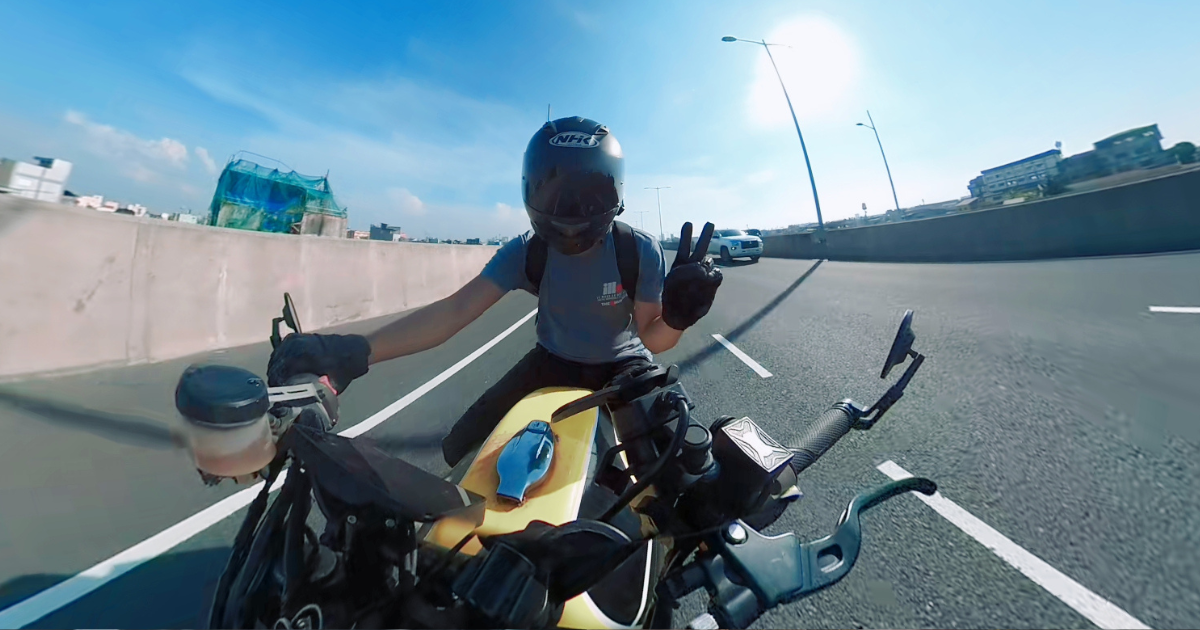
Pando Moto Onyx 02 Gloves Review: The Break-In That Changed Me
Too tight at first, perfectly molded after break-in. Quality leather gloves worth the patience for classic motorcycle riders.

